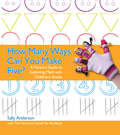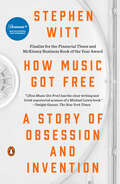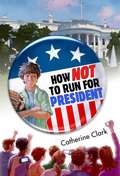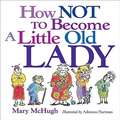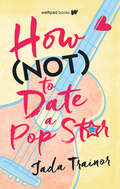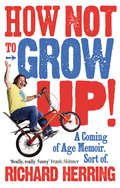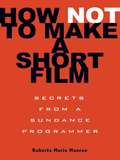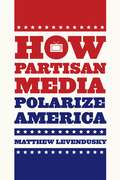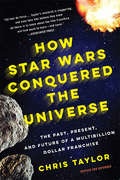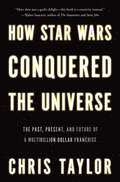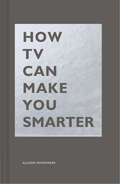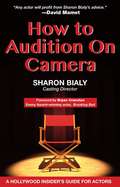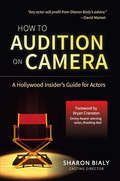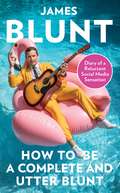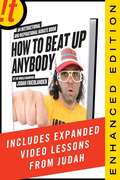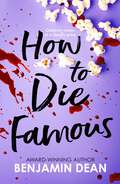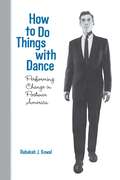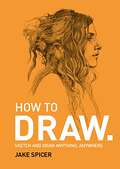- Table View
- List View
How Many Ways Can You Make Five?: A Parent's Guide to Exploring Math with Children's Books
by The Vermont Center for the Book Sally AndersonUse your child’s favorite books to explore and investigate the world of mathematics! In a world filled with patterns, shapes, sequences, and numbers – math is all around us. From an early age, children begin to notice and make connections between math concepts and everyday life, asking: How many? How high? How long? and How much does that weigh?Children’s books can bring math concepts to life. With the help of the stories and activities in How Many Ways Can You Make Five? you and your child will have a blast reading about, talking about, and exploring the world of math. Use favorite children’s books to investigate patterns and puzzles, learn how to subtract, and make maps.With four chapters that cover a multitude of themes, it’s never been easier to deepen your child’s understanding of important math and reading concepts at the same time!
How Many Zen Buddhists Does It Take to Screw in a Light Bulb?
by Matt Freedman Paul HoffmanExamples of the humor craze of the 1980s - the light bulb joke!
How Music Got Free
by Stephen Witt"What happens when an entire generation commits the same crime?"How Music Got Free is a riveting story of obsession, music, crime, and money, featuring visionaries and criminals, moguls and tech-savvy teenagers. It's about the greatest pirate in history, the most powerful executive in the music business, a revolutionary invention and an illegal website four times the size of the iTunes Music Store. Journalist Stephen Witt traces the secret history of digital music piracy, from the German audio engineers who invented the mp3, to a North Carolina compact-disc manufacturing plant where factory worker Dell Glover leaked nearly two thousand albums over the course of a decade, to the high-rises of midtown Manhattan where music executive Doug Morris cornered the global market on rap, and, finally, into the darkest recesses of the Internet.Through these interwoven narratives, Witt has written a thrilling book that depicts the moment in history when ordinary life became forever entwined with the world online -- when, suddenly, all the music ever recorded was available for free. In the page-turning tradition of writers like Michael Lewis and Lawrence Wright, Witt's deeply-reported first book introduces the unforgettable characters--inventors, executives, factory workers, and smugglers--who revolutionized an entire artform, and reveals for the first time the secret underworld of media pirates that transformed our digital lives.An irresistible never-before-told story of greed, cunning, genius, and deceit, How Music Got Free isn't just a story of the music industry--it's a must-read history of the Internet itself.
How Music Got Free: The End of an Industry, the Turn of the Century, and the Patient Zero of Piracy
by Stephen WittFinalist for the 2016 Los Angeles Times Book Prize, the 2016 J. Anthony Lukas Book Prize, and the 2015 Financial Times and McKinsey Business Book of the YearA New York Times Editors' ChoiceONE OF THE YEAR'S BEST BOOKS: The Washington Post * The Financial Times * Slate * The Atlantic * Time * Forbes"[How Music Got Free] has the clear writing and brisk reportorial acumen of a Michael Lewis book."--Dwight Garner, The New York TimesWhat happens when an entire generation commits the same crime?How Music Got Free is a riveting story of obsession, music, crime, and money, featuring visionaries and criminals, moguls and tech-savvy teenagers. It's about the greatest pirate in history, the most powerful executive in the music business, a revolutionary invention and an illegal website four times the size of the iTunes Music Store. Journalist Stephen Witt traces the secret history of digital music piracy, from the German audio engineers who invented the mp3, to a North Carolina compact-disc manufacturing plant where factory worker Dell Glover leaked nearly two thousand albums over the course of a decade, to the high-rises of midtown Manhattan where music executive Doug Morris cornered the global market on rap, and, finally, into the darkest recesses of the Internet.Through these interwoven narratives, Witt has written a thrilling book that depicts the moment in history when ordinary life became forever entwined with the world online--when, suddenly, all the music ever recorded was available for free. In the page-turning tradition of writers like Michael Lewis and Lawrence Wright, Witt's deeply reported first book introduces the unforgettable characters--inventors, executives, factory workers, and smugglers--who revolutionized an entire artform, and reveals for the first time the secret underworld of media pirates that transformed our digital lives.An irresistible never-before-told story of greed, cunning, genius, and deceit, How Music Got Free isn't just a story of the music industry--it's a must-read history of the Internet itself.From the Hardcover edition.
How Not To Run For President
by Catherine Clark"Humorous dialogue, smart pacing and some dirty politics make for an engaging read. With an election around the corner, this isn’t a bad way for young readers to view the political arena. "-Kirkus Reviews When the middle school band is called to play for a presidential campaign rally, Aidan is right there with his clarinet, just in time to save the candidate’s life. Interviewed by the media, he speaks up in favor of the need to save jobs-like his mom’s, for instance. Even though he’s in the middle of Little League season, for pete’s sake, the candidate convinces him to join her tour of the midwest. Problem 1: The candidate’s daughter HATES Aidan. Problem 2: What do you do when your whole life has been turned upside down and you can’t get away from the media? Problem 3: What’s a red-blooded American boy to do when he’s asked to play the clarinet on national TV and the local bully back home is giving interviews saying Aidan’s the nerd of the century?
How Not to Become a Little Old Lady
by Mary MchughYou can be little, and you can be old, but that doesn't mean you have to be a Little Old Lady. We've all seen her. She's hunched forward, her blue hair is tucked neatly under a plastic rain bonnet, she's clutching expired coupons, and she's discussing her latest health problems over lunch. She's a Little Old Lady. . . and she's coming your way at two mph. Little Old Ladies have elastic waistbands on all their slacks. They save rubber bands, remember fifteen-cent McDonald's hamburgers, and have never seen a public rest room that was clean enough. How Not to Become a Little Old Lady is for any woman who is proud to have escaped Little Old Lady-hood, and it's for anyone in danger of slipping into those awful Little Old Lady tendencies.
How Not to Date a Pop Star
by Jada TrainorAaliyah Preston and Tyler Moore were best friends growing up. Tyler played and wrote music, and Aaliyah brought that music to life through dance. They were convinced their lives would change forever after entering a TV talent show, but when Aliyah’s mom ended up in hospital, Tyler had to go alone–and won. Suddenly, he was thrust into the spotlight while she was left behind in their small, seaside town.Several years later, Tyler is the hottest pop star on the planet, and Aaliyah has her heart set on following in her mom’s footsteps and attending the Boston Conservatory to study dance. However, her future becomes hazy when Tyler suddenly comes back home, and wants to make up for all the years they lost–and even plan a future that includes the two of them together.While Tyler may have a lavish lifestyle and fans all the world over, he isn’t happy. What he really wants is a chance at a normal life, and he wants Aaliyah to be part of that life. However, family drama, including long buried secrets about both of their fathers, threaten any plans for their futures. But like the best pop songs, when the music and the lyrics come together everything works in perfect harmony. Tyler and Aaliyah will need to write a new duet without giving up on their dreams.
How Not to Grow Up: A Coming of Age Memoir. Sort of.
by Richard HerringComedian Richard Herring has a major problem. He's about to turn 40 and hasn't seen it coming. He's not married, doesn't have a proper job or 2.4 children. But now, finally, it looks as if the world expects him to be a grown up - and he's completely unprepared for it.As the momentous and terrifying event approaches (his birthday), Richard notices a steep decline in his own behaviour. Inexplicably he begins to behave more childishly - hanging out with 22-year-olds, developing an unhealthy addiction to Flumps and even getting into a ludicrous fight.How Not to Grow Up is the funny story of how a self-confessed perpetual Big Kid deals with his greatest fear - getting older - and is the perfect book for everyone who, deep down, still thinks that they're 18.
How Not to Make a Short Film: Secrets from a Sundance Programmer
by Roberta Marie MunroeAnyone can make a short film, right? Just grab some friends and your handheld and you can do it in a weekend or two before being accepted to a slew of film festivals, right? Wrong. Roberta Munroe screened short film submissions at Sundance for five years, and is an award-winning short filmmaker in her own right. So she knows a thing or two about how not to make a short film. From the first draft of your script to casting, production, editing, and distribution, this is your one-stop primer for breaking into the business. Featuring interviews with many of today's most talented writers, producers, and directors, as well as revealing stories (e.g., what to do when the skinhead crack addict next door begins screaming obscenities as soon as you call "action") from the sets of her own short films, Roberta walks you through the minefield of mistakes that an aspiring filmmaker can make--so that you don't have to make them yourself.r breaking into the business. Featuring interviews with many of today's most talented writers, producers, and directors, as well as revealing stories (e.g., what to do when the skinhead crack addict next door begins screaming obscenities as soon as you call "action") from the sets of her own short films, Roberta walks you through the minefield of mistakes that an aspiring filmmaker can make--so that you don't have to make them yourself.
How Partisan Media Polarize America
by Matthew LevenduskyForty years ago, viewers who wanted to watch the news could only choose from among the major broadcast networks, all of which presented the same news without any particular point of view. Today we have a much broader array of choices, including cable channels offering a partisan take. With partisan programs gaining in popularity, some argue that they are polarizing American politics, while others counter that only a tiny portion of the population watches such programs and that their viewers tend to already hold similar beliefs. <P><P> In How Partisan Media Polarize America, Matthew Levendusky confirms--but also qualifies--both of these claims. Drawing on experiments and survey data, he shows that Americans who watch partisan programming do become more certain of their beliefs and less willing to weigh the merits of opposing views or to compromise. And while only a small segment of the American population watches partisan media programs, those who do tend to be more politically engaged, and their effects on national politics are therefore far-reaching. <P>< In a time when politics seem doomed to partisan discord, How Partisan Media Polarize America offers a much-needed clarification of the role partisan media might play.
How Star Wars Conquered The Universe: The Past, Present, And Future Of A Multibillion Dollar Franchise
by Chris TaylorIn 1973, a young filmmaker named George Lucas scribbled some notes for a far-fetched space-fantasy epic. Some forty years and $37 billion later, Star Wars-related products outnumber human beings, a growing stormtrooper army spans the globe, and "Jediism” has become a religion in its own right. Lucas’s creation has grown into far more than a cinematic classic; it is, quite simply, one of the most lucrative, influential, and interactive franchises of all time. Yet incredibly, until now the complete history of Star Wars--its influences and impact, the controversies it has spawned, its financial growth and long-term prospects--has never been told. In How Star Wars Conquered the Universe, veteran journalist Chris Taylor traces the series from the difficult birth of the original film through its sequels, the franchise’s death and rebirth, the prequels, and the preparations for a new trilogy. Providing portraits of the friends, writers, artists, producers, and marketers who labored behind the scenes to turn Lucas’s idea into a legend, Taylor also jousts with modern-day Jedi, tinkers with droid builders, and gets inside Boba Fett’s helmet, all to find out how Star Wars has attracted and inspired so many fans for so long. Since the first film’s release in 1977, Taylor shows, Star Wars has conquered our culture with a sense of lightness and exuberance, while remaining serious enough to influence politics in far-flung countries and spread a spirituality that appeals to religious groups and atheists alike. Controversial digital upgrades and poorly received prequels have actually made the franchise stronger than ever. Now, with a savvy new set of bosses holding the reins and Episode VII on the horizon, it looks like Star Wars is just getting started. An energetic, fast-moving account of this creative and commercial phenomenon, How Star Wars Conquered the Universe explains how a young filmmaker’s fragile dream beat out a surprising number of rivals to gain a diehard, multigenerational fan base--and why it will be galvanizing our imaginations and minting money for generations to come.
How Star Wars Conquered the Universe
by Chris TaylorHow did a few notes scribbled on a legal pad in 1973 by George Lucas, a man who hated writing, turn into a four billion dollar franchise that has quite literally transformed the way we think about entertainment, merchandizing, politics, and even religion? A cultural touchstone and cinematic classic, Star Wars has a cosmic appeal that no other movie franchise has been able to replicate. From Jedi-themed weddings and international storm-trooper legions, to impassioned debates over the digitization of the three Star Wars prequels, to the shockwaves that continue to reverberate from Disney’s purchase of the beloved franchise in 2012, the series hasn’t stopped inspiring and inciting viewers for almost forty years. Yet surprisingly little is known about its history, its impact#151;or where it’s headed next. In How Star Wars Conquered the Universe Chris Taylor unearths the human-scale stories that have gone into the making of this galactic-sized legend, and describes how and why Star Wars has been such an astonishing success. In a richly detailed narrative, Taylor traces the history of the series from its difficult birth through four drafts, a disastrous first cut, and many sequels and spin-offs. Today, he shows, Star Wars finds itself at a crossroads, with a new company holding the reins and a new trilogy looming on the horizon. Interspersing the story of Star Wars’ evolution with in-depth portraits of all the major names behind the films, as well as reportage about the franchise’s awesome cultural reach and its immensely lucrative business operations, Taylor shows that Star Wars has become ubiquitous: It is loved as much by children as adults, and as much by women as by men. Its action figures now outnumber human beings. And the films themselves have a reach that extends far beyond their viewership; even most so-called Star Wars #147;virgins” know that Darth Vader is Luke’s father, and can identify an Ewok (remarkable, considering that the creatures are never named in any of the Star Wars films). This incredible fertility of the Star Wars universe, Taylor explains, is reflected in its bottom line; the films’ merchandising revenue alone rivals the GDP of a small country. And with the series’ fandom only continuing to grow (despite the general consensus that the recent trilogy was an artistic failure), chances are good that Star Wars will still be galvanizing our imaginations#151;and minting money#151;for generations to come. An energetic, witty account of this stunning cinematic and business success story, How Star Wars Conquered the Universe is the saga of how a young filmmaker’s idle idea became such an immense, transformative cultural force.
How Star Wars Conquered the Universe
by Chris TaylorHow did a few notes scribbled on a legal pad in 1973 by George Lucas, a man who hated writing, turn into a four billion dollar franchise that has quite literally transformed the way we think about entertainment, merchandizing, politics, and even religion? A cultural touchstone and cinematic classic, Star Wars has a cosmic appeal that no other movie franchise has been able to replicate. From Jedi-themed weddings and international storm-trooper legions, to impassioned debates over the digitization of the three Star Wars prequels, to the shockwaves that continue to reverberate from Disney’s purchase of the beloved franchise in 2012, the series hasn’t stopped inspiring and inciting viewers for almost forty years. Yet surprisingly little is known about its history, its impact#151;or where it’s headed next. In How Star Wars Conquered the Universe Chris Taylor unearths the human-scale stories that have gone into the making of this galactic-sized legend, and describes how and why Star Wars has been such an astonishing success. In a richly detailed narrative, Taylor traces the history of the series from its difficult birth through four drafts, a disastrous first cut, and many sequels and spin-offs. Today, he shows, Star Wars finds itself at a crossroads, with a new company holding the reins and a new trilogy looming on the horizon. Interspersing the story of Star Wars’ evolution with in-depth portraits of all the major names behind the films, as well as reportage about the franchise’s awesome cultural reach and its immensely lucrative business operations, Taylor shows that Star Wars has become ubiquitous: It is loved as much by children as adults, and as much by women as by men. Its action figures now outnumber human beings. And the films themselves have a reach that extends far beyond their viewership; even most so-called Star Wars #147;virgins” know that Darth Vader is Luke’s father, and can identify an Ewok (remarkable, considering that the creatures are never named in any of the Star Wars films). This incredible fertility of the Star Wars universe, Taylor explains, is reflected in its bottom line; the films’ merchandising revenue alone rivals the GDP of a small country. And with the series’ fandom only continuing to grow (despite the general consensus that the recent trilogy was an artistic failure), chances are good that Star Wars will still be galvanizing our imaginations#151;and minting money#151;for generations to come. An energetic, witty account of this stunning cinematic and business success story, How Star Wars Conquered the Universe is the saga of how a young filmmaker’s idle idea became such an immense, transformative cultural force.
How Star Wars Conquered the Universe
by Chris TaylorHow did a few notes scribbled on a legal pad in 1973 by George Lucas, a man who hated writing, turn into a four billion dollar franchise that has quite literally transformed the way we think about entertainment, merchandizing, politics, and even religion? A cultural touchstone and cinematic classic, Star Wars has a cosmic appeal that no other movie franchise has been able to replicate. From Jedi-themed weddings and international storm-trooper legions, to impassioned debates over the digitization of the three Star Wars prequels, to the shockwaves that continue to reverberate from Disney’s purchase of the beloved franchise in 2012, the series hasn’t stopped inspiring and inciting viewers for almost forty years. Yet surprisingly little is known about its history, its impact--or where it’s headed next. In How Star Wars Conquered the Universe Chris Taylor unearths the human-scale stories that have gone into the making of this galactic-sized legend, and describes how and why Star Wars has been such an astonishing success. In a richly detailed narrative, Taylor traces the history of the series from its difficult birth through four drafts, a disastrous first cut, and many sequels and spin-offs. Today, he shows, Star Wars finds itself at a crossroads, with a new company holding the reins and a new trilogy looming on the horizon. Interspersing the story of Star Wars’ evolution with in-depth portraits of all the major names behind the films, as well as reportage about the franchise’s awesome cultural reach and its immensely lucrative business operations, Taylor shows that Star Wars has become ubiquitous: It is loved as much by children as adults, and as much by women as by men. Its action figures now outnumber human beings. And the films themselves have a reach that extends far beyond their viewership; even most so-called Star Wars "virgins” know that Darth Vader is Luke’s father, and can identify an Ewok (remarkable, considering that the creatures are never named in any of the Star Wars films). This incredible fertility of the Star Wars universe, Taylor explains, is reflected in its bottom li≠ the films’ merchandising revenue alone rivals the GDP of a small country. And with the series’ fandom only continuing to grow (despite the general consensus that the recent trilogy was an artistic failure), chances are good that Star Wars will still be galvanizing our imaginations--and minting money--for generations to come. An energetic, witty account of this stunning cinematic and business success story, How Star Wars Conquered the Universe is the saga of how a young filmmaker’s idle idea became such an immense, transformative cultural force.
How Sweet it is: the Jackie Gleason Story
by James BaconWritten with the full cooperation of the comedian and his family, this illustrated biography draws a portrait of the man who was one of television's first and biggest stars and who has had careers in clubs, film, and the theater as well.
How TV Can Make You Smarter (The HOW Series)
by Allison ShoemakerHow TV Can Make You Smarter is a lively guide that shows readers the numerous emotional and intellectual benefits of TV. Contrary to conventional wisdom, television can do more than help you veg out, chill, and escape. Author and TV critic Allison Shoemaker rewires our thinking to show readers how to take advantage of our 24/7 access to this ever-evolving medium.• TV is a powerful tool and How TV Can Make You Smarter will teach you how to use it.• Covers a wide selection of diverse genres from scripted comedies, dramas, and classics to reality and beyond• Find acceptance in embracing "bad" TV, and learn to love yourself in the morning.Lessons include learning how to gain empathy (Mad Men), broadening your perspective (Rupaul's Drag Race), and discovering how working within boundaries (Doctor Who) or breaking them apart (Buffy the Vampire Slayer) can be good for you.Part of the HOW series, the accessible and authoritative guides to engaging with the arts the world, and ourselves.• Filled with smart, unintimidating content in a giftable foil-stamped package• Great for TV and movie buffs, Netflix and Hulu subscribers, DVD owners, and anyone who loves to unwind with television• Packed with insightful tips and tricks for making the most out of what you watch• You'll love this book if you love books like Amusing Ourselves to Death: Public Discourse in the Age of Show Business by Neil Postman, Everything Bad Is Good for You: How Today's Popular Culture Is Actually Making Us Smarter by Steven Johnson, and I Like to Watch: Arguing My Way Through the TV Revolution by Emily Nussbaum.
How To Audition On Camera: A Hollywood Insider's Guide for Actors
by Sharon Bialy Bryan CranstonTo win a role in a movie or on network or cable TV, you must make a strong first impression in your brief, crucial audition--and the first person you have to impress is the casting director. In How to Audition On Camera, Casting Director Sharon Bialy answers the twenty-five questions actors ask most frequently about how to nail an audition. What is the casting director looking for? If you mess up, can you start over? What is the most common mistake experienced actors make? Should you audition off book or can you look at the page? Should you dress in character? How much can you improvise? Actors--both novice and professional--are often misled by myths and outdated prescriptions. This guide replaces such misinformation with concise and accurate advice from someone who is in the room helping to make the decision on who gets the job. Bialy gets readers started immediately on the road to screen acting success.
How To Audition On Camera: A Hollywood Insider's Guide for Actors
by Sharon Bialy Bryan CranstonFirst Time in Print Updated and expanded To win a role in a movie or on network or cable TV, you must make a strong first impression in your brief, crucial audition—and the first person you have to impress is the casting director. In How to Audition On Camera, Casting Director Sharon Bialy answers the twenty-five questions actors ask most frequently about how to nail an audition. What is the casting director looking for? If you mess up, can you start over? What is the most common mistake experienced actors make? Should you audition off book or can you look at the page? Should you dress in character? How much can you improvise? Actors—both novice and professional—are often misled by myths and outdated prescriptions. This guide replaces such misinformation with concise and accurate advice from someone who is in the room helping to make the decision on who gets the job. Bialy gets readers started immediately on the road to screen acting success.
How To Be A Complete and Utter Blunt: Diary of a Reluctant Social Media Sensation
by James Blunt'Opinions are like arseholes - everybody has one'James Blunt, 6 December 2014Once upon a time, James Blunt's most enduring legacy was a three-minute, thirty-second pop song about a girl he saw on the underground, and a nation's worth of abuse. But with the invention of Twitter, James found his real voice, and with it, the chance to reply with a simple 'up yours'. Now the King of Twitter has ascended to the heady heights of occasionally 'winning the internet'. Selected and introduced by James himself, this is a year in the life of the world's most reluctant social media sensation. Now learn for yourself how to be a complete and utter Blunt . . .
How To Be A Complete and Utter Blunt: Diary of a Reluctant Social Media Sensation
by James Blunt'Opinions are like arseholes - everybody has one'James Blunt, 6 December 2014Once upon a time, James Blunt's most enduring legacy was a three-minute, thirty-second pop song about a girl he saw on the underground, and a nation's worth of abuse. But with the invention of Twitter, James found his real voice, and with it, the chance to reply with a simple 'up yours'. Now the King of Twitter has ascended to the heady heights of occasionally 'winning the internet'. Selected and introduced by James himself, this is a year in the life of the world's most reluctant social media sensation. Now learn for yourself how to be a complete and utter Blunt . . .
How To Beat Up Anybody
by Judah FriedlanderThe most important book in karate history from the greatest martial artist: The World Champion Judah Friedlander. Finally a Karate book that prepares you for real-life dangerous situations! This book includes chapters on how to beat up Bigfoot, how to beat up someone with one arm, how to beat up someone with three arms, and how to beat up someone on a unicycle. Plus how to beat up street gangs, attackers with weapons, ninjas, dinosaurs, and gangs of street ninjas with weapons riding on dinosaurs! This book contains more than 500 photos! And lots of words! All guaranteeing that you'll learn how to beat up anybody! The World Champion is the greatest athlete in the world, has sex with lots of women, and is a role model to children. For the first time you can now witness his training techniques. Buy this book before he beats you up!
How To Clean Everything: The Authoritative Guide to Cleaning, Conditioning and Stain Removal for Every Type of Material and Surface (3rd Edition)
by Alma Chesnut MooreFrom the book: HOW TO CLEAN EVERYTHING is a comprehensive guide to cleaning any material, removing any stain and caring for any object. This manual, now available from JOB SQUAD, will become so indispensable, you will wonder how you ever managed to clean a home without it! Among the hundreds of tips offered are: Remove chewing gum (if water does not spot the material) by rubbing the gummy portion with a piece of ice. Then you can scrape or rub the gum out of the fabric. Clean a diamond ring by boiling mild soapsuds with a few drips of ammonia added, immersing the ring, dipping it into a small bowl of alcohol, and letting it dry on tissue paper. Remove fresh coffee and tea stains (if it's safe for the fabric) by stretching the stained portion of cloth over an open bowl and securing it with a rubber band. From a height of 1 to 3 feet, pour boiling water over the cloth. From awnings to Venetian blinds, cashmere to silk, coral to vinyl, HOW TO CLEAN EVERYTHING provides the best methods for ensuring a long and beautiful life for your belongings.
How To Die Famous
by Benjamin DeanFrom award-winning author Benjamin Dean comes a deliciously dark and addictive YA thriller following the lives of Gen Z&’s rich and famous through the lens of an undercover teen journalist. Perfect for fans of A Good Girl's Guide to Murder and One of Us is Lying. 'A tense, page-turning YA showbiz thriller' The Guardian 'This [book] has "Netflix adaptation" written all over it.' The Bookseller London-born Abel has landed the role of a lifetime for an upcoming blockbuster. On the face of it he&’s Hollywood&’s latest teen star, but below the surface he&’s an undercover journalist on a mission to expose the &‘squeaky clean&’ entertainment industry and the part they played in his brother&’s &‘accidental&’ death. As Abel steps into the spotlight alongside fellow actors Lucky, Ryan and Ella, he soon discovers that beneath the glittering surface of fame and riches lies a darker world of secrecy, scandal and murder. Nobody is who they seem when the cameras are off, and everybody has something to hide. But who&’s next in line to die famous? Drawing on his previous career as a celebrity journalist, Benjamin Dean examines the dark underbelly of showbiz, leaving no stone unturned.PRAISE FOR BENJAMIN DEAN&’S THE KING IS DEAD: &‘Benjamin Dean has written a royal triumph.&’ Juno Dawson, author of Clean &‘All hail this exquisitely twisty, delightfully queer mystery.&’ Chelsea Pitcher, author of This Lie Will Kill You &‘A compelling thriller that stays with you long after you&’ve finished reading.&’ Kathryn Foxfield, author of Good Girls Die First &‘More jaw-dropping, OMG-twists than even the most salacious tabloid journalist could create.&’ Erik J. Brown, author of All That's Left in the World &‘One page-burning scandal after another. Benjamin Dean is YA royalty.&’ Femi Fadugba, author of The Upper World &‘Addictive, compelling, and utterly delicious.&’ Simon James Green, author of Noah Can&’t Even
How To Do Things with Dance
by Rebekah J. KowalIn postwar America, any assertion of difference from the mainstream anticommunist culture carried professional and personal risks. For this reason, modern dance artists left much of what they thought unsaid. Instead they expressed themselves in movement. How To Do Things with Dance positions modern dance as a vital critical discourse, and suggests that dances of the late 1940s and the 1950s can be seen as compelling agents of social change. Concentrating on choreographers whose artistic work conceived dance in terms of action, Rebekah J. Kowal shows how specific choreographic projects demonstrated increasing awareness of the stage as a penetrable space, one on which socially suspect or marginalized modes of being could be performed with relative impunity and exerted in the real world. Artists covered include Martha Graham, Jose Limon, Anna Sokolow, Katherine Dunham, Pearl Primus, Merce Cunningham, Paul Taylor, Donald McKayle, Talley Beatty, and Anna Halprin.
How To Draw: Sketch and draw anything, anywhere with this inspiring and practical handbook
by Jake SpicerJake Spicer wants you to learn how to draw. This is his complete course in drawing, suitable for complete beginners as well as experienced artists, and designed to help you fit drawing into your lifestyle. Tried-and-tested exercises, ranging from five-minute sketches to dedicated sessions of an hour or longer, cover every subject and location you could wish for, while accessibly written drawing theory helps you relate the technical concepts to your practice, helping you to hone your craft. Whatever your goals are, expert art tutor Jake Spicer gives you the inspiration and encouragement to draw more - and keep improving.
